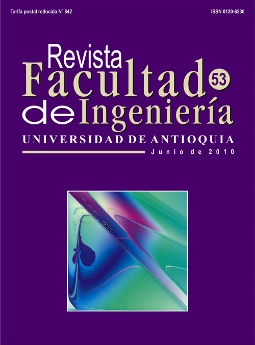Evaluation of the synergistic behavior of erosion-corrosion on steel AISI-SAE 1020 in a multiphase flow brine-CO2-sand by electrochemical techniques
Keywords:
erosion-corrosion, multiphase system, CO2 corrosion, erosionAbstract
The weight loss caused by the phenomenon of erosion-corrosion is not equal to the amount of weight loss of erosion and corrosion when two processes act separately; the synergy between the processes contributes as much as 50% in some cases as it is shown in this research. The tests were conducted in a cell of erosion-corrosion where the dynamic was controlled by the rotating cylinder electrode at speeds between 1.000 and 3.000 rpm, the particle size of SiO2 ranging between 50 and 150 μm, and their concentration between 10 and 30% which defined two regimes of erosion-corrosion: at low rotations, the contribution of the corrosion controlled the degradation phenomenon, and at high rotation, the erosion controlled the degradation of the system.
Downloads
References
M. Ramakrishna, S. Nesic, D. Gulino. “Erosion Corrosion And Synergistic Effects In Disturbed Liquid-Particle Flow”. Corrosion NACExpo. Paper 06594. San Diego (CA). 2006. pp. 1-20.
API RP 571. “Damage Mechanisms Affecting fixed Equipment in the Refining Industry”. American Petroleum Institute. Washington. 2003. pp. 30-53.
J. R. Shadjey, S. A. Shirazi, E. Dayalan, A.E.F. Rybicki. “Prediction erosion-corrosion penetration rate in a carbon dioxide environment with sand”. Corrosion Science. Vol. 54. 1998. pp. 4-73.
M. Vera, N. Ragua. “Efecto de la concentración de partículas erosivas en la corrosión de un acero AISI-SAE 1020 en un sistema salmuera-CO2- arena”. Trabajo de Grado Ingeniería Metalúrgica. Universidad Industrial de Santander. Bucaramanga. 2007. pp. 21-58.
M. Stack, N. Corlett, S. Turgoose. “Some thoughts on modeling the effects of oxygen and a Particle concentration on the erosion-corrosion of steels in aqueous slurries”. Wear. No. 255. 2003. pp. 225-236.
B. Jana, M. Stack. “Modeling impact angle affects on erosion-corrosion of pure metals: construction of materials performance maps”. Wear. No. 259. 2005. pp. 243-255
S. Zhou, M. M. Stack, R. C. Newman. “Characterization of synergistic effects between erosion and corrosion in an aqueous environment using electrochemical techniques”. Corrosion Science. Vol 52. 1996. pp. 934-946.
D. He, X. Jiang, S. Li. “Erosion-corrosion of stainless steels in aqueous slurries – a quantitative estimation of synergistic effects”. Corrosion Science. Vol. 61. 2005. pp 30-36.
M. M. Stack, J. S. James, Q. Lu. “Erosion-corrosion of chromium steel in a rotating cylinder electrode system: some comments of particle size effects”. Wear. Vol. 256. 2004. pp. 557-564.
H. Clark. “A comparison of the erosion resistance of casing steels by sand-oil suspensions”. Wear. Vol. 150. 1991. pp. 217-230.
H. Clark. “Particle Velocity and Size Effects in Laboratory Slurry Erosion Measurements or…do you know what your particles are doing”. Tribology International. Vol. 35. 2002. pp. 617- 624.
A. Levy. “The Platelet Mechanism of Erosion of Ductile Metals”. Wear. Vol. 108. 1986. pp. 1-21.
S. Nesic, B. Brown. “CO2/H2S corrosion under scale forming conditions”. Corrosion NACE International. Paper No. 05625. Houston. 2005. pp. 1-29.
R. Cottis, S. Turgoose. Electrochemical Impedance and Noise. Ed. B. C. Syrett. NACE international. Houston. (USA). 1999. pp 1-48.
Downloads
Published
How to Cite
Issue
Section
License
Copyright (c) 2018 Revista Facultad de Ingeniería

This work is licensed under a Creative Commons Attribution-NonCommercial-ShareAlike 4.0 International License.
Revista Facultad de Ingeniería, Universidad de Antioquia is licensed under the Creative Commons Attribution BY-NC-SA 4.0 license. https://creativecommons.org/licenses/by-nc-sa/4.0/deed.en
You are free to:
Share — copy and redistribute the material in any medium or format
Adapt — remix, transform, and build upon the material
Under the following terms:
Attribution — You must give appropriate credit, provide a link to the license, and indicate if changes were made. You may do so in any reasonable manner, but not in any way that suggests the licensor endorses you or your use.
NonCommercial — You may not use the material for commercial purposes.
ShareAlike — If you remix, transform, or build upon the material, you must distribute your contributions under the same license as the original.
The material published in the journal can be distributed, copied and exhibited by third parties if the respective credits are given to the journal. No commercial benefit can be obtained and derivative works must be under the same license terms as the original work.






 Twitter
Twitter